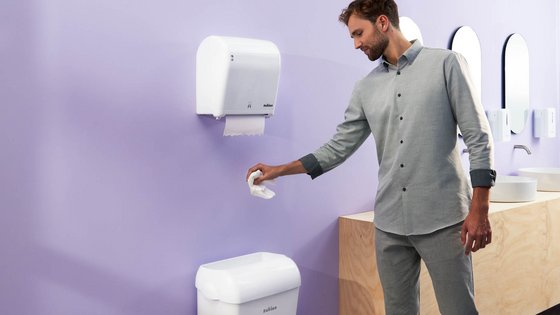So, how can facilities managers prioritise the environment and achieve the EU's goal of climate neutrality by 2050? They can start by making small but impactful changes within the washroom.
The washroom: A sustainability hotspot
While environmental strategies are taking centre stage, the washroom is often an overlooked area where big strides can be made towards sustainability targets by simply making small changes to your procurement decisions. The paper industry, a major contributor to climate change, is a prime area to target for improvement in this area, and luckily, there is a wealth of sustainable hygiene paper options available.
Traditional hygiene paper production can be harsh on the environment. However, paper made from recycled corrugated cardboard (OCC) such as Satino PureSoft, offers a viable alternative.
OCC production uses less energy and water and boasts strong, long-lasting fibres, ideal for high-quality washroom products. Opting for OCC hygiene paper allows facilities managers to contribute to a circular economy and reduce reliance on virgin materials.
Optimising efficiency through technology
Touch-free technology plays a key role in both sustainability and hygiene. Touch-free taps and dispensers reduce water and product waste, while also minimising the spread of germs - a win-win for both the environment and public health. Additionally, motion sensor lights conserve energy by activating only when needed.
How to create a plastic-free path
Every year, millions of tons of plastic pollute our oceans. Facilities managers can significantly reduce plastic waste by switching to reusable and recycled plastic packaging. Look for products with post-consumer recycled plastic (PCR) packaging to keep valuable materials in circulation.
Combatting microplastics
Microplastics, often prevalent in traditional soaps and body washes, pose a threat to marine life. Facilities managers should be aware of ingredients like polyethene, polypropylene, and nylon and opt for microplastic-free alternatives.
Navigating eco-certifications
With stricter environmental regulations on the horizon, understanding eco-certifications is crucial. Key certifications like the Blue Angel, EU Ecolabel, FSC®, and PEFC ensure products meet strict environmental and safety standards. Businesses should prioritise products with these certifications to ensure compliance and contribute to a more sustainable future.
Simple steps, big impact
By implementing these small changes, businesses can significantly reduce their environmental impact. Sustainable hygiene practices not only benefit the environment but also contribute to cost savings and foster social responsibility. Remember, every washroom presents an opportunity to champion sustainability.
Join Satino at Interclean Amsterdam
Want to learn more about sustainable hygiene solutions? Visit Satino at Interclean Amsterdam, 14th – 17th May, to explore our range of eco-friendly washroom products and discuss how we can help you achieve your sustainability goals.

